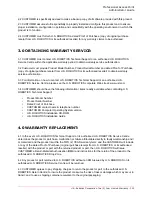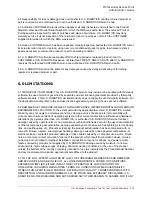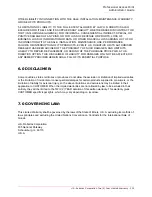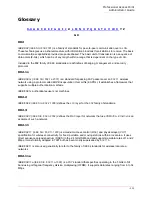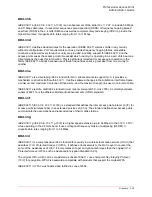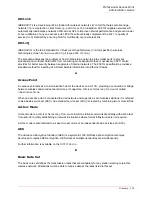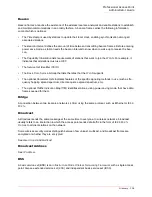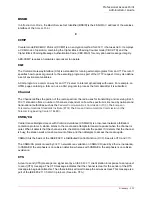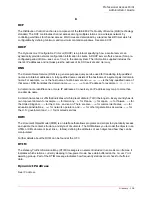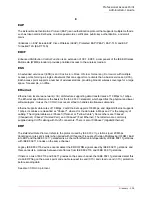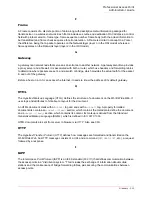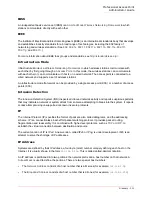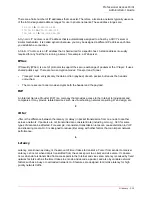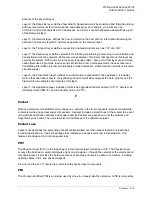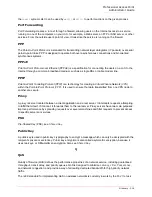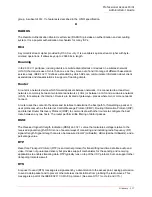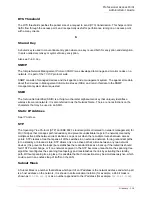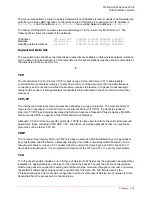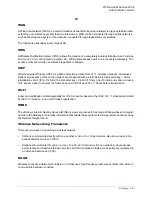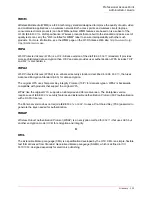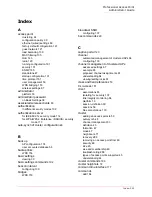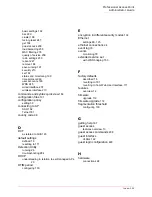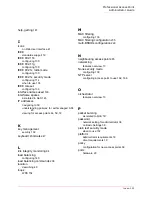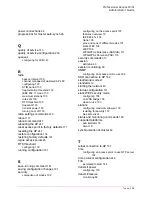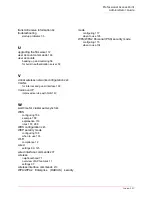
Professional Access Point
Administrator Guide
Glossary - 314
transmit. Any messages larger than the MTU are fragmented into smaller packets before being sent.
Multicast
A
Multicast
sends the same message to a select group of recipients. Sending an e-mail message to a
mailing list is an example of multicasting. In wireless networks, multicast usually refers to an interaction in
which the access point sends data traffic in the form of
IEEE
802.1x
Frame
s to a specified set of client
stations (
MAC
addresses) on the network.
Some wireless security modes distinguish between how unicast, multicast, and broadcast frames are
encrypted or whether they are encrypted.
See also
Unicast
and
Broadcast
.
N
NAT
Network Address Translation
is an Internet standard that masks the internal IP addresses being used in a
LAN
. A NAT server running on a gateway maintains a translation table that maps all internal IP addresses
in outbound requests to its own address and converts all inbound requests to the correct internal host.
NAT serves three main purposes: it provides security by obscurity by hiding internal IP addresses, enables
the use of a wide range of internal IP addresses without fear of conflict with the addresses used by other
organizations, and it allows the use of a single Internet connection.
Network Address
See
IP Address
.
NIC
A
Network Interface Card
is an adapter or expansion board inserted into a computer to provide a physical
connection to a network. Most NICs are designed for a particular type of network, protocol, and media, for
example,
Ethernet
or wireless.
NTP
The
Network Time Protocol
assures accurate synchronization of the system clocks in a network of
computers. NTP servers transmit
Coordinated Universal Time
(UTC, also known as
Greenwich Mean
Time
) to their client systems. An NTP client sends periodic time requests to servers, using the returned
time stamp to adjust its clock.
O
OSI
The
Open Systems Interconnection
(OSI) reference model is a framework for network design. The OSI
model consists of seven layers:
•
Layer 1, the Physical layer, identifies the physical medium used for communication between nodes. In
the case of wireless networks, the physical medium is air, and radio frequency (RF) waves are a com-
Summary of Contents for Instant802 APSDK
Page 1: ...Professional Access Point Administrator Guide R46 1224 00 rev 2 0 07 06...
Page 2: ......
Page 4: ...Professional Access Point Administrator Guide iv...
Page 8: ...Professional Access Point Administrator Guide viii...
Page 42: ...Professional Access Point Administrator Guide Basic Settings 42...
Page 52: ...Professional Access Point Administrator Guide Access Points 52...
Page 58: ...Professional Access Point Administrator Guide User Management 58...
Page 62: ...Professional Access Point Administrator Guide Sessions 62...
Page 70: ...Professional Access Point Administrator Guide Channel Management 70...
Page 88: ...Professional Access Point Administrator Guide Neighboring Access Points 88...
Page 96: ...Professional Access Point Administrator Guide Ethernet Wired Settings 96...
Page 120: ...Professional Access Point Administrator Guide Security 120...
Page 128: ...Professional Access Point Administrator Guide Virtual Wireless Networks 128...
Page 134: ...Professional Access Point Administrator Guide Radio 134...
Page 138: ...Professional Access Point Administrator Guide MAC Filtering 138...
Page 152: ...Professional Access Point Administrator Guide Quality of Service 152...
Page 160: ...Professional Access Point Administrator Guide Wireless Distribution System 160...
Page 164: ...Professional Access Point Administrator Guide Time Protocol 164...
Page 170: ...Professional Access Point Administrator Guide SNMP 170...
Page 290: ...Professional Access Point Administrator Guide Configuration Troubleshooting 290...
Page 298: ...Professional Access Point Administrator Guide Regulatory Information 298...
Page 328: ...Professional Access Point Administrator Guide Index 328...

